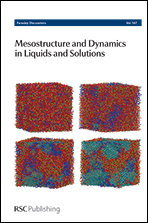Population and size distribution of solute-rich mesospecies within mesostructured aqueous amino acid solutions
Abstract
Aqueous solutions of highly soluble substances such as small amino acids are usually assumed to be essentially homogenous systems with some degree of short range local structuring due to specific interactions on the sub-nanometre scale (e.g. molecular clusters, hydration shells), usually not exceeding several solute molecules. However, recent theoretical and experimental studies have indicated the presence of much larger supramolecular assemblies or mesospecies in solutions of small organic and inorganic molecules as well as proteins. We investigated both supersaturated and undersaturated aqueous solutions of two simple amino acids (glycine and DL-alanine) using Dynamic Light Scattering (DLS), Brownian Microscopy/Nanoparticles Tracking Analysis (NTA) and Cryogenic Transmission Electron Microscopy (Cryo-TEM). Colloidal scale mesospecies (nanodroplets) were previously reported in supersaturated solutions of these amino acids and were implicated as intermediate species on non-classical crystallization pathways. Surprisingly, we have found that the mesospecies are also present in significant numbers in undersaturated solutions even when the solute concentration is well below the solid–liquid equilibrium concentration (saturation limit). Thus, mesopecies can be observed with mean diameters ranging from 100 to 300 nm and a size distribution that broadens towards larger size with increasing solute concentration. We note that the mesospecies are not a separate phase and the system is better described as a thermodynamically stable mesostructured liquid containing solute-rich domains dispersed within bulk solute solution. At a given temperature, solute molecules in such a mesostructured liquid phase are subject to equilibrium distribution between solute-rich mesospecies and the surrounding bulk solution.
- This article is part of the themed collection: Mesostructure and Dynamics in Liquids and Solutions

 Please wait while we load your content...
Please wait while we load your content...